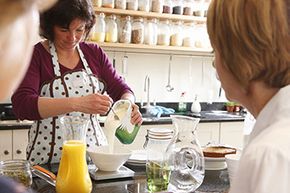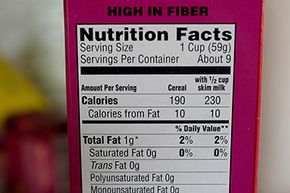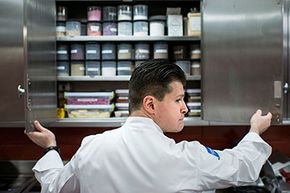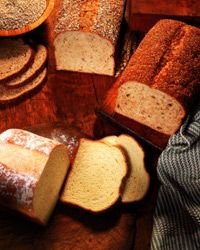You've probably seen those scary headlines that say a slice of peanut butter cheesecake from The Cheesecake Factory has 1,330 calories. Where did that figure come from? Or you might be creating your own recipe and are curious about how many calories are in the dish. Is it as simple as adding up the calories in the ingredients you included and dividing it by the number of servings? Yes and no. Determining the calories in our food is a mix of art and science.
A quick primer: A calorie is a unit of measurement, and one specifically used to measure energy. One calorie is equal to the amount of energy it takes to raise the temperature of 1 gram of water 1 degree Celsius (1.8 degrees Fahrenheit). Since calories measure energy, they apply to more than just food. A gallon of gas, for example, contains 31 million calories [source: University of Texas Arlington].
Advertisement
The calories listed on food packages actually refer to kilocalories; 1,000 calories = 1 kilocalorie. To indicate a measurement is in kilocalories, the word "calories" is sometimes capitalized.
You may also notice "(kcal)" next to the numerical calorie count. A food calorie (that is, a kilocalorie) is 1,000 times larger than a calorie used in chemistry. Why is it important to know how many calories are in our food? We need energy to stay alive, and we obtain this energy from the foods we eat. If we know how many calories are in our food, we'll know how much energy we can obtain. For instance, your single serving pack of oatmeal might say it has 160 calories. If you were to set it on fire and it burned completely, it would produce 160 kilocalories or food calories of energy — enough to raise the temperature of 160 kilograms of water 1 degree Celsius [sources: University of Texas Arlington, Scientific American]. It's also helpful to keep tabs on calories to make sure we're not taking in too few or too many.
The original method of determining the number of calories in food required the use of something called a bomb calorimeter. You'd seal a food item into a metal container, then stick it into an insulated container of water and burn it. The water temperature was measured before and after to come up with the calorie count. Bomb calorimeters aren't used much today. Instead, calories are estimated by mathematics, specifically the Atwater system. The Atwater system, developed around the late 19th century, uses the following figures, which were originally obtained by burning foods' energy-providing components and averaging the results [source: Scientific American]:
1 gram alcohol = 7 calories
1 gram carbohydrate = 4 calories
1 gram fat = 9 calories
1 gram protein = 4 calories
Using the Atwater system, the calories in a food's energy-providing components (protein, carbs, fat and alcohol) are added together. Next, the indigestible fiber in the carbohydrates is subtracted out. This leaves a food's final calorie count. To determine calories per portion, you simply take the item's total calorie count and divide it by the number of portions you desire.
Advertisement




